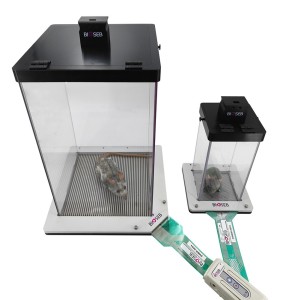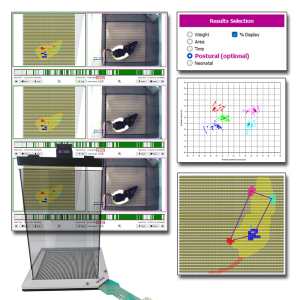Authors
PT, Wu, CH. Hsu, FC. Su, IM Jou, SY. Chen, CL. Wu, WR. Su, LC. Kuo
Lab
Department of Orthopedics, College of Medicine, National Cheng Kung University, Tainan, Taiwan
Journal
Scientific Reports
Abstract
Few studies discuss kinetic changes in tendinopathy models. We propose a customized corridor to evaluate dynamic weight bearing (DWB) and shearing forces. Sixty rats were randomly given ultrasound-assisted collagenase injections (Collagenase rats) or needle punctures (Control rats) in their left Achilles tendons, and then evaluated 1, 4, and 8 weeks later. The Collagenase rats always had significantly (p < 0.001) higher histopathological and ultrasound feature scores than did the Controls, significantly lower DWB values in the injured than in the right hindlimbs, and compensatorily higher (p < 0.05) DWB values in the contralateral than in the left forelimbs. The injured hindlimbs had lower outward shearing force 1 and 4 weeks later, and higher (p < 0.05) push-off shearing force 8 weeks later, than did the contralateral hindlimbs. Injured Control rat hindlimbs had lower DWB values than did the contralateral only at week 1. The Collagenase rats had only lower static weight bearing ratios (SWBRs) values than did the Controls at week 1 (p < 0.05). Our customized corridor showed changes in DWB compatible with histopathological and ultrasound feature changes in the rat tendinopathy model. The hindlimb SWBRs did not correspond with any tendinopathic changes.
BIOSEB Instruments Used
Dynamic Weight Bearing 2.0 (BIO-DWB-DUAL)
Source :

 Douleur - Allodynie/Hyperalgésie Thermique
Douleur - Allodynie/Hyperalgésie Thermique Douleur - Spontanée - Déficit de Posture
Douleur - Spontanée - Déficit de Posture Douleur - Allodynie/Hyperalgésie Mécanique
Douleur - Allodynie/Hyperalgésie Mécanique Apprentissage/Mémoire - Attention - Addiction
Apprentissage/Mémoire - Attention - Addiction Physiologie & Recherche Respiratoire
Physiologie & Recherche Respiratoire




































 Douleur
Douleur Système Nerveux Central (SNC)
Système Nerveux Central (SNC)  Neurodégénérescence
Neurodégénérescence Système sensoriel
Système sensoriel Système moteur
Système moteur Troubles de l'humeur
Troubles de l'humeur Autres pathologies
Autres pathologies Système musculaire
Système musculaire Articulations
Articulations Métabolisme
Métabolisme Thématiques transversales
Thématiques transversales Congrès & Meetings
Congrès & Meetings 
